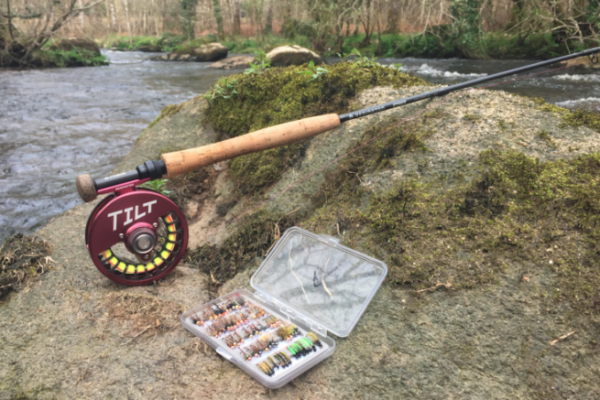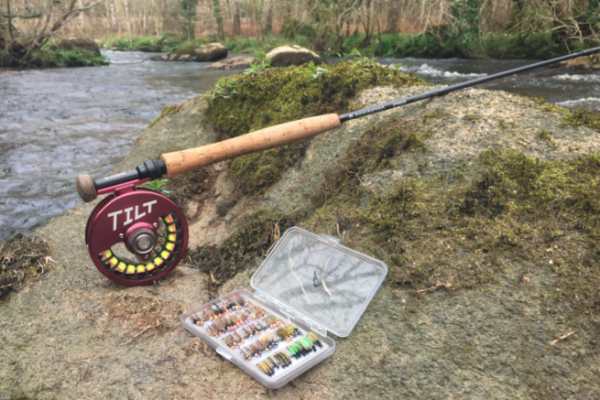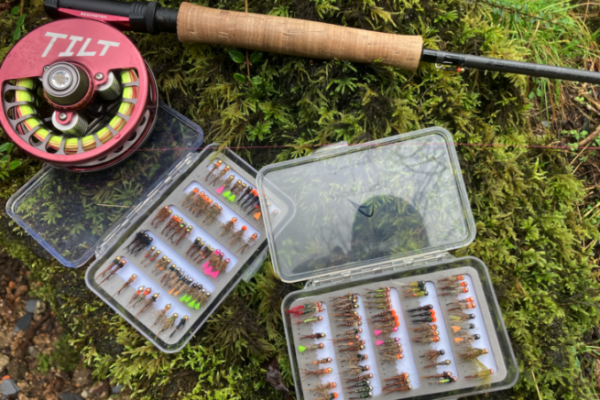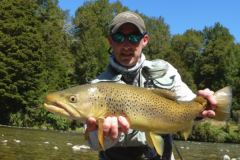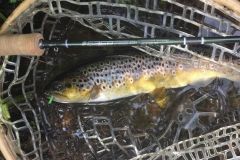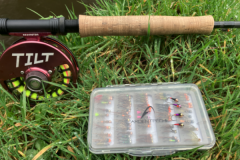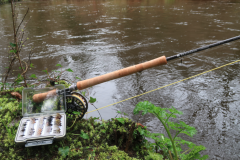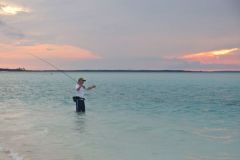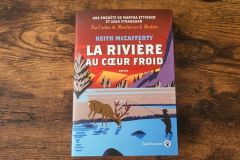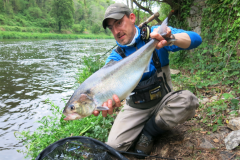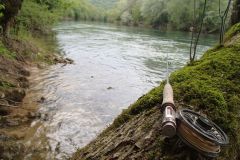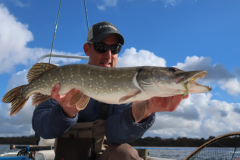What is line nymph fishing?
The principle of the thread nymph is to offer one or two nymphs (weighted flies) mounted with a ball in the head to sink quickly and be presented in the current veins where the angler assumes trout are posted.
This technique can be practised with a plated line, in which case our conventional equipment can be used, with the use of a line, a leader and a touch indicator to detect when our imitation is gripped by a trout. For this technique, we generally use nymphs that are not too heavily weighted, and the line (greased) is therefore placed on the water, allowing us to follow the drift and visualize the bite by stopping the line.
The technique most commonly used nowadays is the "European line", i.e. with a long rod, specifically designed for this technique in order to benefit from a greater leverage arm and a longer length than a conventional rod to achieve good drifts. The line is of little or no use, and it's the weight of the nymph or nymphs that makes it possible to cast to the target with a flick of the wrist.
A coloured nylon indicator, detached from the water and generally at a 45° angle to the water surface, will allow us to visualize our drift and identify hits by twitching, slowing or stopping the line.
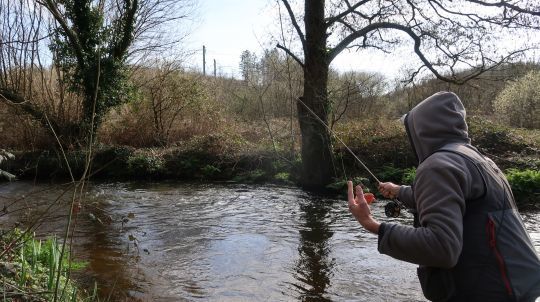
Basic equipment for wire nymphing
The rods most commonly used for line nymph fishing are generally between 10 and 11 feet long (1 foot = approx. 30 cm), but in larger rivers they can exceed this size.
In most cases, these rods will have wattages between 2 and 5.
They are more flexible than conventional rods, so that you can cast one or two flies without using the weight of the line, which will often be in the reel, and strike with fine tips without too great a risk of breakage. The better the quality of the rod, the greater the resonance of the blank and the lighter the weight of the rod.
For the reel, which is of little interest, there are two opposing styles. A semi-automatic reel and a conventional reel.
The important thing is to have a reel that balances your rod to keep a 45° angle during your drifts without tiring of keeping the rod high.
It's also advisable to use a reel with a closed frame to prevent the line from passing between the spool and the frame itself. Reels specifically designed for wire nymphing are available from all the leading brands.
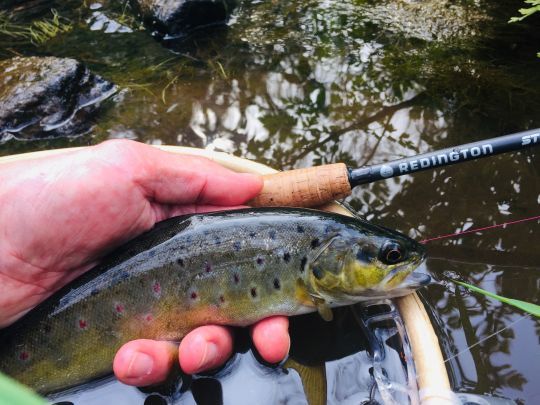
The line body will often be made of a highly visible colored line in pink, bright yellow (chartreuse or fluorescent) or orange in 18°, 16° or 14° diameters. Some anglers use transparent nylon + an indicator. Others only use coloured line, followed by the tip.
In competition, the leader attached to the end of a line (parallel fine) must not exceed two rod lengths. For leisure fishing, you can use as much line as you like. We generally wind 10 to 15 metres of coloured (or transparent) line onto the end of the leader.
A Rio two-tone nylon indicator of about 40 cm will be added to the end of your line body. If a coloured line body is used, a visual break with transparent nylon can be placed between the line body and the indicator. This makes it easy to locate the indicator.
It will play the main role of informing you about the drift of your flies and when the trout have taken your imitation.

Then, under the indicator, a nylon tippet is added, to which one or two flies are attached (a second fly may be used). The diameter of the fly will depend on the size of the trout to be fished.
The length of the tip will depend on the depth of the target. It's important to change the tip regularly depending on the depth of the position fished, so that the indicator is level with the surface of the water to detect bites. A length of one and a half times the average depth is generally used, as the line will be at an angle underwater for most of the drift as it is cast upstream.
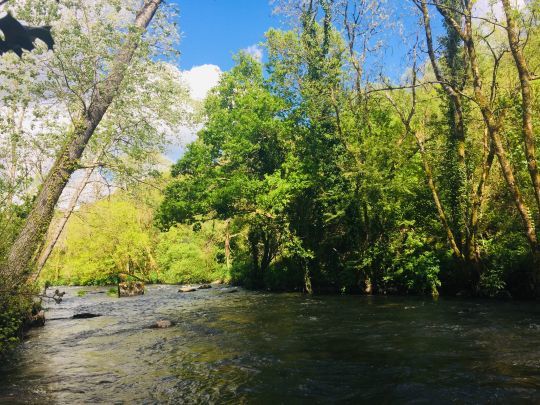
The basic principles of line nymph fishing
The principle is to offer the trout one or two nymphs in the water layer and to create drifts as natural as possible to overcome the fish's distrust.
To achieve this, three important points need to be taken into account: water reading, nymph weight and drift quality.
- Water reading
As with dry fishing, sight nymphing or any other technique, reading the water will be very important and will enable you to quickly know where to cast your flies.
The positions change according to the season and therefore the water temperature, which determines the placement of the fish in the river.
- Nymph weight
The weight of your nymph(s) is crucial and must be adapted to each current vein.
A good nymph angler will know very quickly, based on his experience in the field, what fly weight to use for each position. This is based on his analysis of fish activity, but above all on his reading of the positions (depth and current speed).
The basic principle is to change nymph weight according to current speed and depth. You need to regularly change the weight of your nymph(s) to fish correctly, as a nymph that is too heavy will not drift naturally and will move slower than the current, and will regularly hit the bottom or snag. Conversely, a nymph that is too light will drift too fast and often too high in the water.
- Drift quality and presentation
The quality of the drift is the most important factor, and is itself linked to the water reading and experience in this technique.
The weight of your nymph(s) determines the presentation and quality of the drift.
Then it's the way the angler gets his nymphs through that will trigger the bites. If the drifts are not good (underwater dragging of the nymphs), the fish will sulk at your flies.
Good drifting is something you learn as you go along, because at first it's not easy to identify the right weight and how to match your rod to the current speed.
